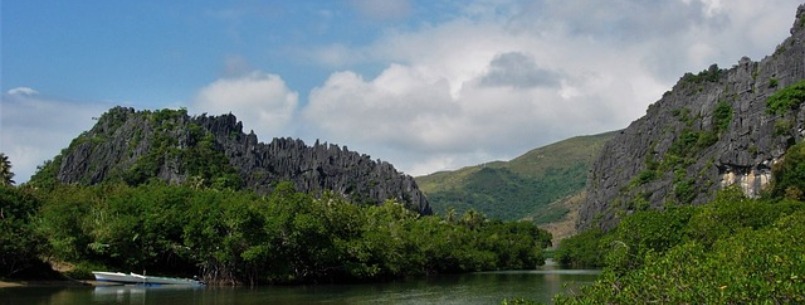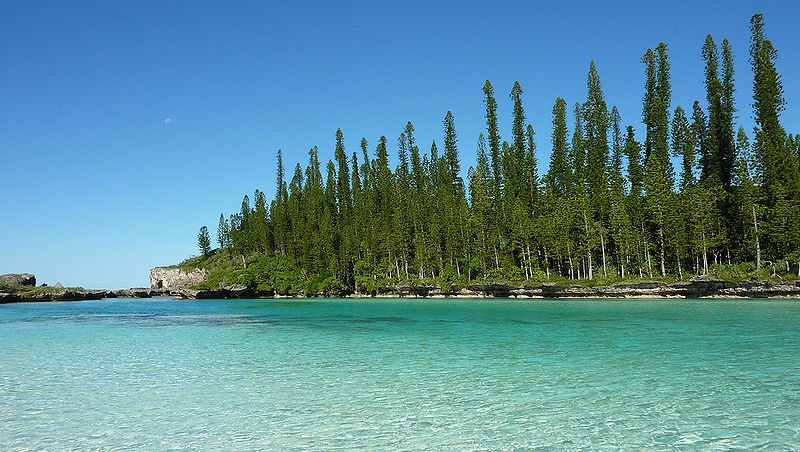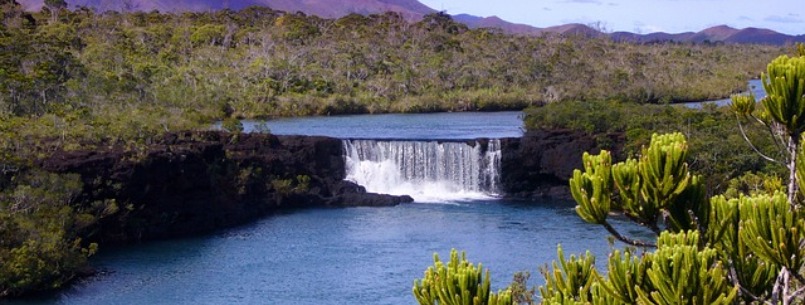New Caledonia in Melanesia is an oasis in the South Pacific, a land of contrast, splendor and excitement. Whether you are wanting unspoiled, deserted beaches, the bright lights of nightclubs and casinos or cuisine unlike any you have experienced, you will find it all here. Venture to the biggest lagoon in the world with its breathtaking coral and marine life. Or hit the shops for designer labels and chick fashions. In harmony with the Melanesian culture, the French have brought European style and elegance to New Caledonia. The “French ambiance” is described by many like the taste of France in the South Pacific. This is the romance of New Caledonia.

CAPITAL AND MAJOR CENTERS
Noumea, New Caledonia’s only city, is the place where most people start their New Caledonian experience. From the delights of the colonial layout of downtown to the local museum with its Melanesian theme, you will never tire of the sights in Noumea. Tontouta International Airport is around 45 minutes north and Magenta Domestic Airport is just a few minutes’ drives from the city center.
The mainland, known as “Grand Terre”, is the main island of New Caledonia and offers a diverse range of scenery, sites, and activities. It covers a four-kilometer long area from north to south and is 50 kilometers wide from west to east. South and East of the mainland lie the Isle of Pines and the Loyalty Islands of Mare, Lifou, Ouvea and Tiga – little jewels of the Pacific which have all the features and charm of the South Seas. Tranquil bays around a turquoise-blue expanse of the sea blend with white sandy beaches to create a vision of paradise.
THE PEOPLE
The population of 200,000 is predominantly Melanesian and European with small groups of Wallisians, Tahitians, Indonesians, and Vietnamese. The official language is French. There are about 30 different Melanesian dialects, but English is widely spoken particularly in the tourist industry.
HISTORY
On September 4th, 1774, Captain James Cook discovered New Caledonia which he named because the mountains in the Balade area where he anchored reminded him of Scotland. Eighteen years later Frenchman Bruni d’Entrecasteaux, while searching for the missing navigator La Perouse stopped at Balade and the Isle of Pines.
 The Loyalty Islands were explored in 1827 by Dumont d’Urville, who mapped the archipelago in 1840. The first settlers here were English missionaries, and in 1843, the French missionaries settled at Balade where, on September 24th, 1853, Admiral Febvrier Despointe took official possession of New Caledonia by order of Napolean III.
The Loyalty Islands were explored in 1827 by Dumont d’Urville, who mapped the archipelago in 1840. The first settlers here were English missionaries, and in 1843, the French missionaries settled at Balade where, on September 24th, 1853, Admiral Febvrier Despointe took official possession of New Caledonia by order of Napolean III.
In 1862, Admiral Guillian became Governor and established a penal settlement for convicts and political prisoners. In 1957, New Caledonia became a French Overseas Territory.
NATURE
The animal life consists of many species, some of which are not found elsewhere. The Cagou (a flightless bird which is New Caledonia’s symbol), the green pigeon, the Crested Parrot, and the flying fox are in abundance, as well as wild pigs and deer which inhabited the bush and mountains.
The coast is bordered by beaches of golden sands with occasional stretches of mangrove forests. On the eastern coast are coconut palms and luxuriant vegetation, abundant flowers, numerous streams and waterfalls. On the west, the majestic gum tree savannah and the valleys are coated with dense forests.
There is a sharp contrast in vegetation in the south for it has an abundance of high pine trees known as Cook pines. In the north, there are vast areas of flat plains. More than three thousand species of plants have been classified, many of which are endemic to the territory. The eucalyptus is unique to the area and widespread throughout the main island, as are the kaoris, bougainvilleas and banyans.

THE SIGHTS
At the center of the city in Noumea is an attractive gardened square surrounded by numerous streets with interesting shops and one of the highlights of any visit to New Caledonia is the new Tjibaou Cultural Centre. There is also the Parc Forestier (botanical and zoological garden) and the Noumea Aquarium, world-renowned for its tropical fish, fluorescent corals and nautilus. Discover the markets or lunch in an outdoor cafe. The long beaches at Baie des Citrons or Anse Vata are great places to relax and go windsurfing, snorkeling or diving. Enjoy a game of golf at Tina International 18 hole golf course situated only ten minutes from Anse Vata. A good way to start your holiday is to take a short city tour by coach or tourist train. Just a short drive away and in total contrast, you can explore the unspoiled bushlands and other sights such as the Provincial Park of the Blue River or the Mount Koghi forest.
New Caledonia has a good road network. The mainland is divided by the central mountain range creating a tropical east and a dry west. A land of stockman and rodeos, where extensive stock farming is predominant. This is a surprising province with its Farino market, treks in Mount Koghi, Bourail with its museum, Turtle Bay and the Pierced rock, the beach of Poe and excursions on horse-back organized at La Foa, Boulouparis, Kone and Koumac. There are fascinating diving tours from Bourail, Nepoui and Malabou.
The east coast is the tropical adventure, with its abundant vegetation, wide rivers, spectacular waterfalls, coconut groves and coffee plantation. Don’t miss a visit to Hienghene from where some excursions are recommended such as diving tours, kayaking, and horse riding.
GETTING AROUND
Air Caledonie offers frequent flights (air pass and packages) from Noumea-Magenta Domestic Airport to Isle of Pines, Loyalty Island, Kone, Koumac and Touho. There is also a ferry service between Noumea, the Loyalty Islands and the Isle of Pines. Regular bus services operate throughout the mainland. In Noumea, the bus station ensures a regular service around the entire town. Car rental, taxis, and a little train are also available.
FOOD AND ENTERTAINMENT
Cuisine plays a vital part in the way of life in New Caledonia. Where else in the South Pacific but Noumea would you find more than 130 restaurants, serving a variety of styles including French provincial, Indonesian, Chinese, Italian, French traditional, Mexican, Japanese, plus seafood specialties.

ACTIVITIES
For those who like sports, you can windsurf, scuba dive, snorkel, jet ski, sail, and surf. Facilities include an Olympic pool, tennis court, squash clubs, bowling, golf courses and playing fields for rugby, cricket, and soccer.
SHOPPING GUIDE
This is the land of the siesta, so shops open from 7.30 a.m. to 11.30 a.m. and 2 p.m. to 6 p.m. Duty free stores offer a wide variety of luxury, designer goods from French fashion houses and there are imported French food, wines and a range of electrical goods, radios, cameras, watches, etc. In the colorful markets are fish, vegetables, oranges and tropical fruits such as pawpaws and the pineapple as well as handmade articles.
TRAVEL ACCOMMODATION GUIDE
A range of accommodation is available throughout the territory from serviced apartments and one to five-star hotels/resorts, to rural or tribal lodgings (‘gites’) within a Melanesian village or property, where camping is permitted.
The Southern Province is the most densely populated of New Caledonia and comprises some seven thousand square kilometers approximately 40% of the whole territory. The capital, Noumea, is a garden city where long strolls are a pleasure. Walk along the beautiful beaches of Anse Vata and Baie des Citrons and enjoy browsing in the French-influenced boutique. Places to visit include the Territorial Museum dedicated to the archaeology and ethnology of Oceania, the new Cultural Centre, the City of Noumea Museum, the Geological Museum and the Maritime History Museum, the Bernheim Library and St. Joseph’s Cathedral.
Nature lovers will enjoy the Aquarium of Noumea, the colorful variety of the local produce market, and the Zoological and Forest Park where you can see the rare endemic Cagou, the emblem of New Caledonia. Attractions not far from Noumea include dazzling white sandy beaches, mangroves with mud crabs, the taboo Fatanaoue Caves where the mummies of high Kanak chiefs are laid to rest, the Pierced Rock, a huge cliff with caves and ending with Le Bonhomme, an enormous monolith sculpted by waves. Tourists can also visit the Cave Perrin winery and the orchids of the Amieu Pass, the museums of Bourail and Paita, and Rusa deer farms.
There are numerous hikes and horseback excursions available, including many close to Noumea. Take a hiking or 4WD trip to the south beyond Noumea, a wild and mysterious region which despite a barren appearance provides an exceptional haven for its Flora and Fauna. Contrasting with the vast red-ochre landscape is the Blue River Provincial Park with its ancient trees and rare animals. Other places of interest include the Madeleine Waterfall, a botanic reserve and picnic/swimming spot, The Yate Dam, the Giant Kaori tree of Mount Goro and Wadiana Waterfall, the Woodin Canal, the Bay of Prony, and Keubini beach with its myriad islets popular with yachties. From Noumea it is possible to take excursions to the numerous islands and islets in the southwest lagoon:
- Ile aux Canards (Duck Island) is easily accessible by windsurfers and taxi boats.
- Ilot Maitre, a boat ride of about 15 minutes from Noumea, lies in the center of a vast underwater reef and offers
remarkable scuba diving. A popular spot for weekenders from Noumea. - Ilot Amedee (lighthouse), about 40 minutes by boat is one of the most popular excursions from Noumea. The 56 meter high, 130 years old lighthouse which dominates the island was built under Napoleon III. Its sparkling lagoon is popular for diving and snorkeling.
- Ilot Laregnere is accessible either by a 35-minute motor-boat ride from Noumea or as part of an excursion.
- Ilot Signal, surrounded by white beaches, was fitted with the first beacon for the entrance into the Port-de-France Harbour.
- Ilot Casy, in the middle of the Bay of Prony, is an isolated nature reserve with many of the features of the mainland. Excursions from Noumea is by seaplane and minibus.
- Ouen Island is halfway between Noumea and the Isle of Pines and is renowned for its turtles and jade mines. Boat transfers are organized from Noumea’s Port Moselle.
Loyalty Islands
The archipelago of the Loyalty Islands lies 100 kilometers east of mainland New Caledonia, separated by a 2,500-metre deep strait. With a total area of 2,500 square kilometers, the Loyalty Islands consist of four inhabited raised coral atolls – Lifou, Mare, Ouvea and Tiga. The Loyalty Islands were so named toward the end of the 18th century by the British merchant ships that discovered these islands and found these people of dual Melanesian and Polynesian heritage to be ‘honest and agreeable’. Aside from their legendary friendliness to visitors, the islanders have preserved intact their clans, customs, and natural and cultural history.
Today the Loyalty Islands offer visitors a pure South Pacific experience with diverse sites of great natural beauty from coconut palms lining curved white sandy beaches, to unspoiled marine depths, plunging cliffs and dense forests. The islands offer a multitude of leisure activities including scuba diving, pleasure boating, deep-sea fishing, excursions, nature walks, and cross-country biking. All tourist facilities are available including car hire, guided tours, banks, post office and medical dispensaries.
Lifou Island
Formerly called Drehu, at 1,150 square kilometers, Lifou is the largest and most varied of the islands. Located on the shores of Chateaubriand Bay, the village of We is the capital and main administrative and commercial center of the Province. Lifou’s 10,000 inhabitants live in three tribal districts, Wetr, Lossi and Gaitcha. The interior of this ancient atoll is a vast forest-covered plateau. Approaching the island from the east or west, wild terraced cliffs pierced by caves plunge into the emerald sea, interspersed by long white sandy beaches. The south coast is also studded with caves and is home to the Bay of Wanda with its marine turtle park. Sandalwood Bay to the west gained its name from the early sandalwood merchants.
In the north is spectacular Doking, where a tribe lives on the side of a 40-meter high cliff overhanging magnificent clear water and extremely beautiful coral teeming with fish. During their annual migration from August to September, whales cruise past these cliffs to scratch off the many small shells that have accumulated on the skin of their backs.
Other places to visit include the Devil’s Cave at Tingeting (with a guide), the Chapel ‘Notre Dame of Lourdes’ at Easo, Mucaweng vanilla plant, the church and temple of Qanono, and a guided tour of the ‘Jewels of Luengoni’ Cave.
Mare Island
The southernmost and ‘most authentic’ island, Mare is the highest of the four Loyalty Islands. Its 7,000 inhabitants live in the island’s eight districts: Guahma, Tadine, Wabao, Eni, Medu, Laroche, Tawainedre and Penelo. An island of contrasts, there are five-story high cliffs, basalt rocks, dark forests, and small coves with caves and powdery white sand beaches lining the clear waters of the lagoon. On the west coast between stands of coconut palms and pines, a superb natural rock pool is framed by the coral.
Both the architecture and the regular cultural ceremonies bear testimony to the fact that the islanders are deeply attached to their traditions. One of the most captivating local events is the Yam Festival.
Sites worth visiting included the Warrior’s Jump, where legend has it that cornered by the enemy, a warrior leaped across the five-kilometer gap in the cliff. The Leperhouse Well, a 50 meter well opening into one of the deepest underground freshwater lakes in the world, the ancient fortifications of the village of La Roche, the Bone Hole, a 40-meter deep limestone cave, and the seawater fed Natural Aquarium.
Ouvea Island
Ouvea is the smallest of the Loyalty’s three main islands and is known as the ‘magic’ island. One of the most beautiful coral atolls of the Pacific, time stands still here and the abundant fishing is still the principal source of income.
Sights include the Cliffs of Lekine dotted with caves overlooking the bay, Maouli Bridge for splendid views of Lekine Bay and Mouli Island, Fayanoe Beach, a spectacular 23 km stretch of unbroken white beach fringing the iridescent blue lagoon, and the Blue Hole of Anawa, a series of fresh and saltwater waterholes providing a sanctuary for turtles as well as swimming pools for the island’s children. Also visit the village of Saint Joseph with its church, and Cong-Ouloup Cave, although prior permission is required from the Chief and it is best to go with a guide.
Tiga Island
Located north of Mare, Tiga, the ‘proud’ island is a tiny 12 square kilometer atoll rising from the middle of the ocean. Its humped shape is explained by a legend telling how a sea turtle agreed to carry a rat from Lifou across to Mare, but stopped halfway. Tiga’s only tribe lives on fishing and copra production, and there are no facilities for tours or accommodation.
Drehu Village & Nengone Village
Experience the remote beauty of the Loyalty Islands at Drehu Village hotel which has 20 bungalows on the island of Lifou, and Nengone Village with 15 bungalows on Mare. Both properties are located on stretches of magnificent white sand beaches and the comfortable air-conditioned bungalows can accommodate up to four persons. All have a terrace overlooking the ocean, private bathroom, telephone, TV and video and safe deposit. At Drehu Village, you just step away from the beach or the pool, and Nengone Village’s bungalows are situated on a secluded creek lined by tropical forest.
The hotels’ restaurants off a la carte culinary specialties from the islands or set menus. Exotic cocktails can be enjoyed by the pool or at the hotel lounges. Snorkeling equipment and table tennis are free of charge at both hotels. Also free at Nengone Village is kayaking. There are bicycles and cars for hire, and at Drehu, one can also hire motorbikes, hobie-cats and sailboards.
Guided tours to the spectacular sites and native tribes of the islands, as well as transfers to and from the local airport or wharf, can be organized by both hotels. Additional attractions on Lifou include scuba diving and big game fishing and Mare’s sights include a Cultural Centre.
Renowned for their friendly service, the Loyalty Islands are ideal for a few days relaxation and to explore the pleasures of the islands’ way of life.
